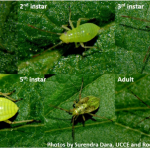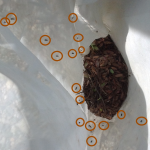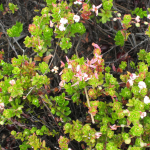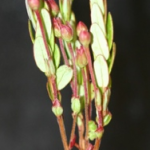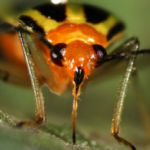Blunt-nosed Leafhopper in MA Cranberry
BLUNT-NOSED LEAFHOPPER IN MA CRANBERRY
Limottetix vaccinii (Van Duzee)
(Hemiptera: Cicadellidae)
Martha M. Sylvia and Anne L. Averill University of Massachusetts-Amherst Cranberry Station, East Wareham, MA May 2023
This is a draft edition of the blunt-nosed leafhopper fact sheet. We are not familiar with this insect in conventional MA cranberry and will create new editions as we learn more.
So far, we have not seen blunt-nosed leafhopper outbreaks in MA on beds where a program of broad-spectrum insecticides is followed in the spring.

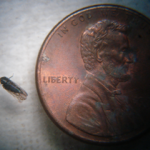
Adult blunt-nosed leafhopper. The adult stage of the leafhopper is readily picked up in the sweep net all through July if an infestation exists. These insects are very small: above image shows comparison of the full-grown insect (adult) alongside a penny. (Images: Charlie Armstrong, UMaine)
We have not seen blunt-nosed leafhoppers on typically managed MA bogs. We have begun an extensive survey to determine its current status.
In MA cranberry, we have seen modest populations on two low-input beds and one organic bed. We have seen high population on abandoned and wild bogs. Large populations are common on New Jersey beds. They have appeared on Maine and Wisconsin beds for a number of years.
Blunt-nosed leafhopper is critically important because it is the vector of cranberry false blossom disease. However, we have only seen false blossom on one bed several years ago. We see false blossom regularly on wild bogs out on Cape Cod. There is no treatment for false blossom disease and diseased uprights do not produce berries.
BIOLOGY
In natural settings, blunt-nosed leafhopper is abundant on leatherleaf, dwarf huckleberry and fetterbush, and is less abundant on sheep laurel [according to HJ Franklin (1950)]. In New Jersey, according to CS Beckwith and SB Hutton (1929), in the vicinity of bogs, blunt-nosed leafhopper appears to prefer cranberry. Several other leafhopper species may be picked up in sweeps, so care must be taken to carry out correct identification.
Beckwith, CS and SB Hutton. 1929. Cranberry false blossom and the blunt-nosed leafhopper. Bull 491. NJ Agricul. Exp. Sta. New Brunswick, NJ
Franklin, H.J. 1950. Cranberry Insects in Massachusetts. Bulletin No. 445 parts II-VII. MA Agricul. Exp. Sta. East Wareham, MA 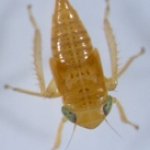

Blunt-nosed
leafhopper nymph on left. It has developing wing buds and cannot fly. Adult leafhoppers are seen in July, on right. It now has functional wings. (Images: E. de Lange, Rutgers)
There is one generation of blunt-nosed leafhopper per year. In late summer, females insert eggs lengthwise under the bark of the cranberry stem. The egg stage overwinters. Egg hatch begins in early spring. In 2023, we found 1st instar nymphs (just hatched) during the 2ndweek of May. The insect goes through five instars (an instar is a developmental stage between molts). At first, the nymphs are whitish and 1/20th of an inch long. Intermediate instars are pale yellow or dark yellow and final instars are darker, and are greenish-grey, or yellow. The nymphs take about a month to complete development to winged adults.

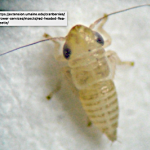
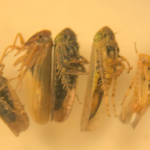
FEEDING
All feeding stages of the leafhopper have mouthparts that are a tubular, jointed beak. The beak is inserted into the plant stem, leaves or buds in order to access the plant juices, which are sucked up.
VINE INJURY
Direct feeding injury to the vine has not been observed. Transmission of the false blossom pathogen is the problem with these leafhoppers.
MANAGEMENT
Acetamiprid (Assail), diazinon, and carbaryl (Sevin) are effective insecticide choices, according to reports from NJ.
Pre-bloom (mid-May to June) sweeping to detect the nymphal stage of the leafhopper is advisable, but it is exceedingly difficult. They are very small and are hard to pick out when Collembola are abundant. We have only been successful in detecting them by putting the sweep net contents into gallon zip-lock bags and then examining them with a microscope with a fiber-optic light.
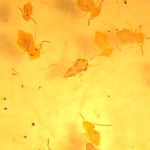 Immigration of leafhoppers from nearby abandoned or low-input beds could put a neighboring bed at risk, which should be carefully monitored. New hybrid plantings should also be carefully monitored.
Immigration of leafhoppers from nearby abandoned or low-input beds could put a neighboring bed at risk, which should be carefully monitored. New hybrid plantings should also be carefully monitored.
BLUNT-NOSED LEAFHOPPERS SPREAD FALSE BLOSSOM DISEASE. THERE IS NO TREATMENT ONCE THE VINES ARE INFECTED.
False blossom is a disease caused by a phytoplasma, which is bacteria-like, and which resides in the upright’s phloem. When the blunt-nosed leafhopper feeds on false blossom-infected plants, they acquire the phytoplasma and can transmit it to healthy vines when they next feed. The very distinctive symptom of cranberry false blossom is the malformation of the cranberry flower. When the diseased flower opens, the flower stands erect and the petals look more daisy-like than the healthy down-facing flowers. The flower is often off-color and may be deeper pink or red.
